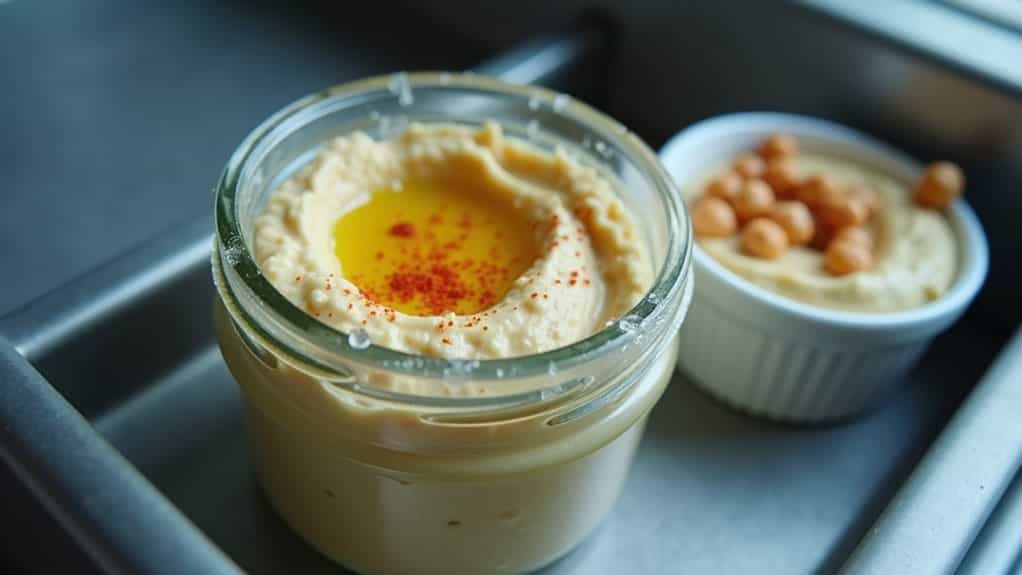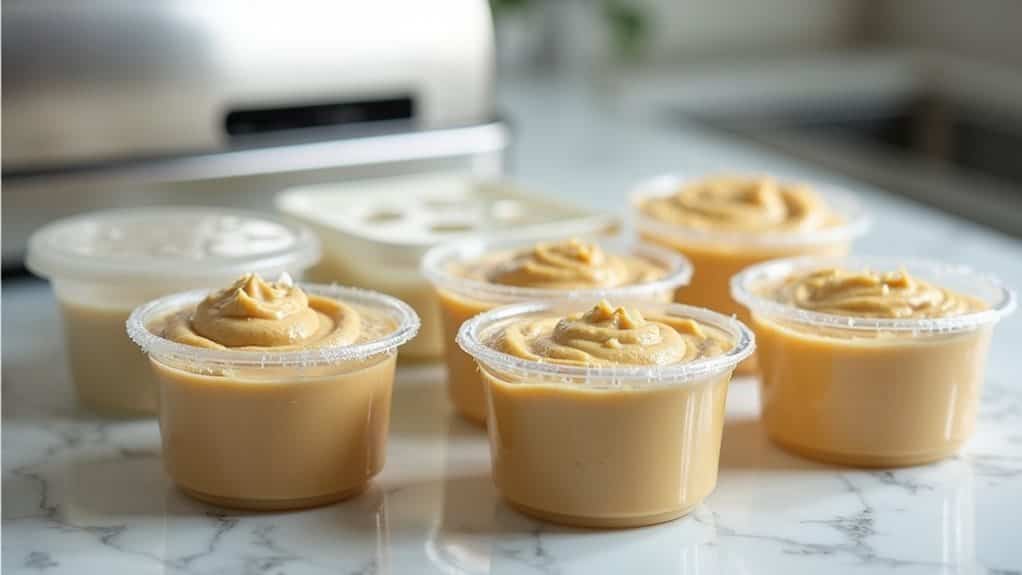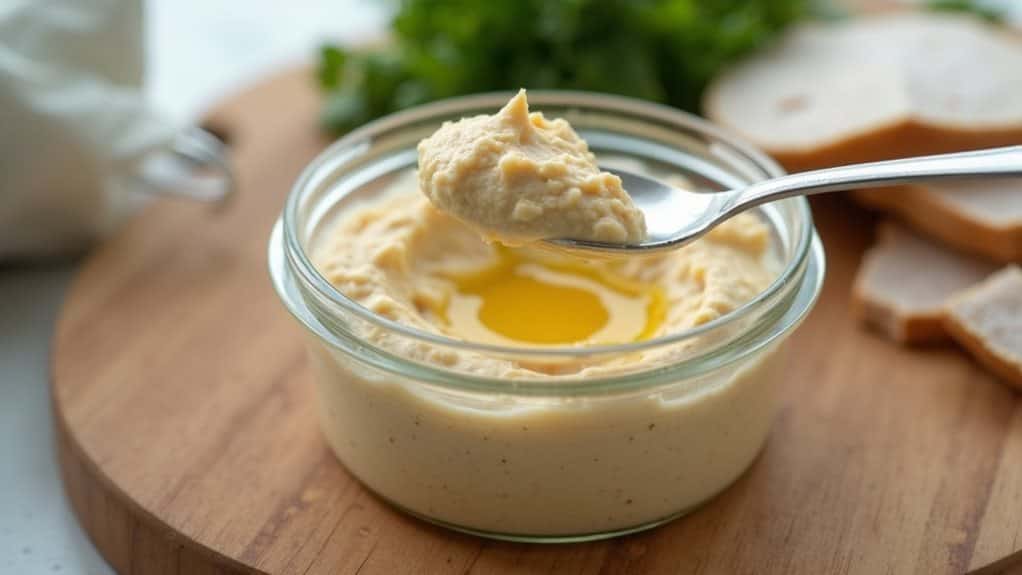You can freeze hummus to extend its life and keep portions handy, but do it right to protect flavor and texture. Use airtight, freezer-safe containers or flattened freezer bags, leave headspace, and label with dates; plan single-use portions like half-cup servings or ice-cube trays. Thaw slowly in the fridge, then stir or reblend with a bit of oil or tahini to restore creaminess, and eat within 3–5 days after thawing — keep going for tips on containers, thawing, and fixes.
Quick Guide
- Yes — both store-bought and homemade hummus can be frozen safely for up to about four months, best within two months for quality.
- Portion hummus into meal-sized containers, ice-cube trays, or flattened freezer bags to speed thawing and avoid waste.
- Use airtight, freezer-safe containers with headspace and drizzle a thin layer of olive oil on top to reduce freezer burn and dryness.
- Thaw slowly in the refrigerator 12–24 hours (or cold-water/microwave for speed), then stir or reblend to restore creaminess.
- After thawing, refrigerate and consume within 3–5 days, discarding if off-smelling, molded, or unusually discolored.
Why Freezing Hummus Is Safe and Useful

Because freezing keeps food temperatures consistently low, it’s a reliable way to stop bacterial growth and make hummus safe to store longer than refrigeration allows. Proper storage techniques, like using airtight containers, can also help extend hummus shelf life and prevent freezer burn and contamination. Thaw in the refrigerator to reduce bacterial risk, stir to restore texture, and eat within a few days after thawing for safety. Freezing hummus can extend its shelf life for up to 4 months, making it a good option for meal prepping and reducing waste.
How Long Can You Keep Hummus in the Freezer
Freezing hummus can extend its shelf life substantially, but you’ll want to keep track of dates and portions to maintain quality and safety; most hummus — whether homemade or store-bought — stays good in the freezer for up to about four months, though for best taste and texture you should aim to use it within two months. Proper storage can help ensure that your hummus remains fresh for as long as possible. Label containers, freeze in small portions, and expect some texture changes; thaw in the fridge and consume within 3–5 days, discarding any with off-smells, mold, or unusual discoloration. Many people also find that adding a thin layer of olive oil before freezing helps preserve moisture and mouthfeel, especially for homemade hummus.
Best Containers and Packaging for Freezing Hummus

When you freeze hummus, choosing airtight, freezer-safe containers will protect texture and prevent freezer burn while keeping flavors intact.
For flexible, space-saving portioning, use high-quality freezer bags flattened for quick thawing or filled into meal-sized servings and sealed tightly.
Label each package with the date and leave a bit of headspace or room for expansion so your containers don’t crack and your hummus stays fresh. Additionally, storing hummus in sealed containers helps maintain quality and prevents spoilage, similar to best practices for chia seeds.
Airtight Freezer-Safe Containers
Choosing the right airtight freezer-safe container makes a big difference in keeping hummus fresh and flavorful, and you’ll want to take into account material, lid design, and portion size before you pack it away.
Use tempered glass, freezer-grade plastics, or silicone with tight, gasketed lids, leave headspace for expansion, pack meal-sized portions, label dates, and avoid cracked or non-food-grade containers to prevent odor, leaks, and freezer burn.
Portioning With Freezer Bags
Portioning hummus into freezer bags lets you grab just what you need and cuts down on waste, so it’s worth doing right.
Use quality freezer-safe resealable bags, flatten portions to half- or one-cup sizes, remove air, seal tightly, and label with date.
Freeze flat on a tray, stack when solid, then thaw in fridge or cold water and stir to restore creaminess.
Portioning Strategies for Easier Thawing
Break your hummus into smaller portions before freezing so you’ll thaw only what you need and avoid texture changes that come from large blocks warming unevenly.
Freeze no more than 12 ounces per container and use half-cup servings for single meals.
Use ice cube trays or Souper Cubes for uniform portions, label dates, leave headspace, and drizzle a bit of olive oil to help preserve moisture. Additionally, freezing in smaller portions helps maintain the quality and texture of the hummus.
Preparing Hummus for Freezing: Do’s and Don’ts

When you’re getting hummus ready for the freezer, focus on texture and sealing: puree your chickpeas with reserved aquafaba or water until the mixture is smooth but still slightly loose, since hummus firms up when frozen, then transfer it to airtight, freezer-safe containers leaving about an inch of headspace and a thin drizzle of olive oil on top to reduce moisture loss. Use moderate garlic, label. Additionally, to maintain quality, airtight storage is essential to prevent spoilage and maintain flavor.
Thawing Methods That Preserve Texture and Flavor
Getting hummus back to its creamy best starts with choosing the right thawing method, since how you thaw it greatly affects both texture and flavor.
You can thaw slowly in the refrigerator 12–24 hours, speed it with a cold water bath for 30–60 minutes, or use microwave defrost in short intervals.
Always keep containers sealed, stir after thawing, refrigerate promptly, and consume within 3–5 days.
Fixing Texture Changes After Thawing

You followed the right thawing steps, but thawed hummus can still look and feel off; fortunately, you can often restore its creaminess with a few practical fixes.
Vigorously stir or reblend, adding a little olive oil, tahini, or yogurt as needed, or warm gently then emulsify. Stabilizers like xanthan help if used before freezing, and proper pre-freeze blending reduces future graininess.
Creative Uses for Thawed Hummus
Repurposing thawed hummus opens up lots of practical options beyond just dipping, so you can turn a slightly changed texture into a delicious component of many meals.
Spread it on toast, bagels, or wraps, or mix with yogurt for creamy sandwiches. Stir into pasta, mashed vegetables, or dressings. Dollop on grain bowls, baked potatoes, or use blended variants as flavored dips or tart fillings.
Wrapping Up
You can safely freeze hummus to extend its shelf life and cut down on waste, but you’ll want to portion it first so you only thaw what you’ll use. Use airtight containers or freezer bags, remove excess air, and label with the date; frozen hummus stays good about 3 months. Thaw in the fridge and stir or whisk to restore creaminess, adding a splash of olive oil or water if it’s grainy. Use thawed hummus in dips, spreads, or cooked dishes.


